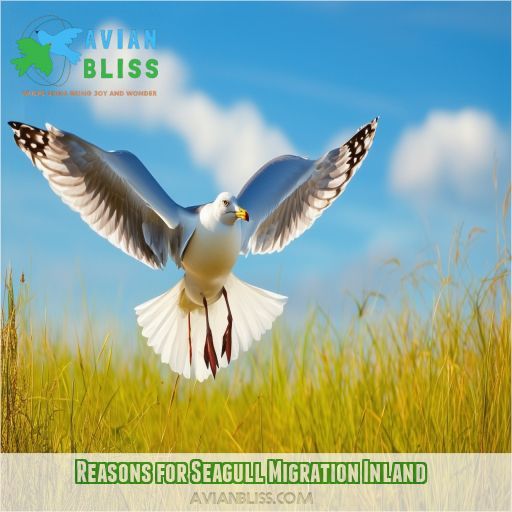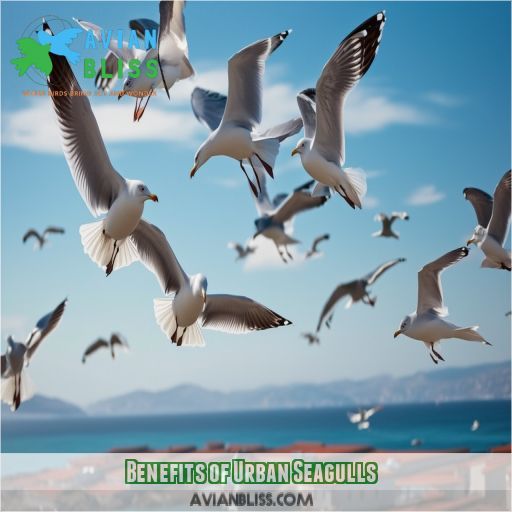This site is supported by our readers. We may earn a commission, at no cost to you, if you purchase through links.

Their increasing appearance in cities is an exciting phenomenon, compelled by several factors. From plentiful food supplies to more secure habitats to raise their young, cities hold unexpected attractions for these resourceful birds.
Knowing why seagulls move inland reveals much about urban ecology and the consequences of human activities on wildlife behavior. Let’s understand what causes this coastal migration to city life for these birds
Table Of Contents
- Key Takeaways
- Why Are There Seagulls Inland?
- Reasons for Seagull Migration Inland
- Impact of Urban Seagulls
- Methods to Deter Urban Seagulls
- Benefits of Urban Seagulls
- Pest Control Options
- Frequently Asked Questions (FAQs)
- What does it mean when seagulls fly inland?
- Why are there seagulls inland in parking lots?
- Why are there seagulls in my neighborhood?
- What do seagulls eat inland?
- Do inland seagulls differ genetically from coastal populations?
- How far inland have seagulls been recorded nesting?
- Can seagulls survive solely on urban food sources?
- Do inland seagulls migrate differently than coastal ones?
- How do urban seagulls communicate and socialize?
- Conclusion
Key Takeaways
- Seagulls are flying the coop from coastal areas, trading sand for skyscrapers as they flock to cities for an all-you-can-eat buffet of urban leftovers and safer nesting spots.
- These feathered opportunists are giving city pest control a run for their money, gobbling up insects and rodents while moonlighting as impromptu garbage collectors.
- urban gull-watching isn’t just for the birds – it’s a chance to witness nature’s adaptability in action and maybe learn a thing or two about coexisting with our winged neighbors.
- While some may cry foul over their noisy presence, these plucky birds are inadvertently serving as canaries in the coal mine for our changing environment and urban ecosystems
Why Are There Seagulls Inland?
You’ve probably noticed seagulls far from the coast, and you’re not imagining things. These adaptable birds are increasingly migrating inland due to changing conditions.
Why are there seagulls inland? It’s a combination of factors: disruptions in their traditional fish supply, abundant urban food sources (think overflowing bins), and safer nesting options away from coastal predators.
Cities offer a smorgasbord of opportunities for these clever scavengers. While their presence can be a nuisance, urban seagulls also provide some benefits like pest control and waste management.
As these coastal birds become city-dwellers, they’re reshaping our urban ecosystems. There’s more to this seagull saga than meets the eye
Reasons for Seagull Migration Inland
You’ve likely noticed seagulls venturing far from coastal areas, a phenomenon driven by several factors. These include disruptions in their traditional fish supply, the abundance of food waste in urban areas, safer nesting opportunities on buildings, and a decline in rural seagull populations along the coast
Disruption in Fish Supply
You’ve likely noticed more seagulls in urban areas lately. This inland migration is largely due to disruptions in their traditional fish supply. Changes in the fishing industry have led to:
- Reduced catch sizes
- Altered fishing locations
- Shifts in targeted fish species
These factors have forced coastal birds to seek alternative food sources. As competition for dwindling marine resources intensifies, seagulls are adapting by exploring inland breeding sites and urban nesting opportunities, challenging public perception and necessitating new habitat management strategies
Abundant Urban Food Sources
You’ll find seagulls flocking to urban areas due to the abundance of food sources. These coastal birds have adapted to city life, drawn by:
- Overflowing litter bins
- Easily accessible food waste
- Poorly secured bin bags
- Irregular collection times by local councils
This urban adaptation has reduced coastal competition and increased inland breeding. While some view seagulls as pests, they’re simply responding to the food availability you’ve inadvertently provided. It’s a stark example of how human behavior impacts wildlife
Safer Nesting Habitat
You’ll find seagulls flocking to urban areas for safer nesting spots. Cities offer a reprieve from marine competition and inland predators, giving these clever birds a cozy home. During nesting season, you’ll spot them on rooftops and in city squares, far from their traditional coastal habitats.
- Less competition for prime nesting locations
- Reduced threat from natural predators
- Abundance of building materials for nest construction
- Protection from harsh coastal weather conditions
Decline in Rural Seagull Populations
You’ll notice fewer seagulls at traditional coastal sites, pushing these adaptable birds inland. This decline in rural seagull populations is driven by several factors:
- Coastal development eroding natural habitats
- Human pressure forcing gulls to seek new territories
- Negative perception leading to active discouragement
As seagull numbers dwindle along the coast, they’re finding new homes in urban areas. It’s a balancing act between wildlife coexistence and human needs, with gulls adapting to survive in our ever-changing world
Impact of Urban Seagulls
You’ll notice urban seagulls scavenging for food, often stealing from tourists and workers, which can turn them into pests, especially for the food industry. Their presence in cities also raises concerns about noise, nuisance, and potential health risks from their droppings
Scavenging Behavior
As seagulls move inland, you’ll notice their scavenging behavior intensifying. Urban foraging has become their forte, with these adaptable birds exploiting food availability in cities. You might witness:
- Seagulls raiding bins for discarded chicken and other treats
- Bold birds snatching food from unsuspecting humans
- Flocks descending on waste management sites
This human-wildlife conflict is reshaping public perception of seagulls, turning them from coastal icons to urban opportunists. Their scavenging behavior highlights the need for better waste management practices in our cities
Pest Issues
As seagulls adapt to urban life, they’re becoming more than just scavengers. You’ll notice these coastal interlopers causing pest issues in your city. Here’s how they’re shaking things up:
- Seagull aggression: They’ll swoop down, snatching food from your hands.
- Food chain disruption: Urban gulls compete with local wildlife for resources.
- Nesting site competition: They’re taking over prime real estate, pushing out other birds.
These brown-bodied birds, with over 50 different species, are tipping the ecosystem balance inland
Health Risks
Beyond being pests, urban seagulls pose potential health risks. Their droppings can contaminate surfaces and water sources, leading to public health concerns. You might encounter:
- Avian diseases transmitted through contact with droppings
- Respiratory issues from airborne particles in dried feces
- Contamination of food and water supplies
- Increased risk of slips and falls on droppings-covered surfaces
As climate change triggers more tropical storms, we may see mass movements of these marine birds with webbed feet further inland, amplifying these health challenges
Methods to Deter Urban Seagulls
To deter urban seagulls, you can employ physical barriers like bird netting and spike strips to prevent roosting and nesting. You might also consider using auditory deterrents such as ultrasonic devices or modifying the habitat by regularly cleaning areas and removing potential food sources
Physical Deterrents
You’ve got options to keep those pesky seagulls at bay! Physical deterrents can be your secret weapon in managing urban gull populations. By altering the habitat quality and implementing nesting management strategies, you’ll make your space less attractive to these coastal interlopers.
Here are some effective physical deterrents:
- Bird netting to block access
- Spike strips on ledges and roofs
- Visual deterrents like reflective tape
- Olfactory deterrents to repel gulls
- Chemical deterrents applied to surfaces
Auditory Deterrents
You’ve tried physical barriers, but those seagulls just keep on coming? It’s time to tap into auditory deterrents. These devices use high-pitched sounds to have the feathered pests flying for the hills. What you need to know:
- Conduct regular audits to ensure the effectiveness of deterrents
- Choosing the correct device for your specific seagull problem
- By avoiding sound frequency to avoid disturbing humans
Habitat Modification
While auditory deterrents may prove effective, habitat modification works much better. You can further make your urban space less attractive to seagulls by:
- Removing food sources
- Sealing Garbage Containers
- Repair anti-roosting devices
- Modifying building structures
These alter biodiversity and food chain dynamics and may, therefore, break this delicate balance concerning urban ecosystems. Other species are bound to be affected due to intensified habitat competition. Risks of disease transmission and public perception should also be considered to ensure these modifications are balanced.
Benefits of Urban Seagulls
While urban seagulls are often seen as a nuisance, they offer several benefits to city environments. They provide natural pest control by consuming insects and rodents, help manage waste by scavenging litter, serve as indicators of environmental health, and offer educational opportunities for observing wildlife in urban settings
Pest Control
Although they’re a nuisance, seagulls have the surprising benefit of being natural pest controllers. These coastal birds you’ll find:
- Devouring insects that damage crops
- Hunting urban rodents
- Reduction of requirements of chemical pesticides
- Keeping pests in check around landfills
Their presence significantly reduces populations of harmful pests, hence obviating trapping or poisoning. By accepting seagulls for their function in pest management, you’re opening yourself to a natural and green solution for urban pest control.
Waste Management
Urban seagulls play a surprising role in waste management. You’ll often see them:
- Swooping down to snatch discarded food
- Picking through trash bins with surgical precision
- Congregating at landfills, reducing organic waste
- Cleaning up litter in parks and beaches
Their scavenging behavior, while sometimes annoying, helps keep cities cleaner. By consuming urban waste, seagulls inadvertently assist in managing our ecosystem. This natural cleanup crew impacts population health and habitat management, highlighting the complex relationship between wildlife and urban environments
Environmental Indicators
Urban gulls are excellent environmental indicators because they indicate just how good or bad our city ecosystems are. Their presence and behaviors can express precisely critical information regarding:
- Species distribution across urban landscapes.
- Habitat selection in human-dominated landscapes
- Wildlife tolerance by humans in urban environments
- Ecological balance in urban environments
Educational Value
Urban seagulls offer unique educational opportunities, allowing you to observe wildlife up close. Their presence in cities provides a window into urban ecology and animal behavior. You can engage in citizen science projects to study seagull populations, fostering a deeper understanding of human-wildlife interactions.
Here are three ways to learn from urban seagulls:
- Observe their foraging techniques
- Track nesting patterns on buildings
- Document adaptations to city life
These firsthand experiences can spark curiosity about ecology and inspire conservation efforts right in your backyard
Pest Control Options
If you’re struggling with urban seagulls, professional pest control companies can offer expertise in exclusion techniques and deterrents. They’ll assess your specific situation and implement strategies like bird netting or ultrasonic devices, while lethal control is typically considered only as a last resort
Professional Assistance
Although most urban seagulls are helpful in many ways, they can sometimes turn out to be trouble. If you have persistent issues, then professional pest control services will likely be your best bet. These professionals can offer:
- Personalised solutions based on your unique situation
- Effective, humane methods to deter the seagulls
- Habitat Modification Strategies in Long-term
- Advice on coexistence and public perception management
Notice the cost-effectiveness and long-term effects of professional help. It’s a balanced approach to saving urban habitats and human peace of mind.
Exclusion and Deterrents
If you can’t afford professional help, there’s something you can do yourself. Exclusion and deterrence methods can work very satisfactorily in controlling urban seagulls. Here are strategies that may be of interest:
- Installing bird netting over vulnerable areas
• Laying spike strips in potential roosting sites
- Using ultrasonic devices to emit high-pitched sounds
- Deploying visual deterrents like fake owls or hawks
- Regularly cleaning and removing waste food
Such methods would make the habitat less hospitable to seagulls and improve public understanding and education in coexistence with urban nesting habits.
Lethal Control
When all other methods fail, you might consider lethal control as a last resort for managing urban seagull populations. However, this approach carries significant ethical implications and potential long-term effects on ecological balance. Before implementing any lethal measures, carefully weigh:
- Animal welfare concerns
- Impact on local biodiversity
- Public safety considerations
Frequently Asked Questions (FAQs)
What does it mean when seagulls fly inland?
When seagulls fly inland, you’re witnessing nature’s adaptability. They’re seeking food, safety, or nesting sites. It’s often a sign of changing coastal conditions or urban opportunities. You’ll notice them scavenging in cities, parks, and landfills
Why are there seagulls inland in parking lots?
Did you know that 20% of urban seagulls now nest on buildings? You’ll spot them in parking lots because they’re adapting to city life. They’re drawn by easy food sources like litter and the safety of open spaces
Why are there seagulls in my neighborhood?
You’re seeing seagulls in your neighborhood because they’ve adapted to urban life. They’re drawn by easy food sources like trash and open fields. Your area likely offers safe nesting spots and plentiful meals, making it an attractive home for these resourceful birds
What do seagulls eat inland?
You’d think seagulls inland crave caviar, but they’re not that picky. They’ll devour your leftovers, scavenge landfills, and snatch insects. They’ve adapted to urban buffets, feasting on everything from discarded fast food to worms in parks
Do inland seagulls differ genetically from coastal populations?
Inland seagulls don’t differ much genetically from their cousins living by the sea. These are resilient birds but not some kind of subspecies. Their existence inland is more behavioral in nature than genetic change. It’s Nature’s way of survival.
How far inland have seagulls been recorded nesting?
You’ll find seagulls nesting surprisingly far inland. They’ve been recorded breeding up to 100 miles from the coast in some areas. Urban centers, with their tall buildings and abundant food sources, have become particularly attractive nesting spots for these adaptable birds
Can seagulls survive solely on urban food sources?
The seagulls are like urban chameleons that learn to adjust to city life. You’ll find, in most cases, they can survive very well on a smorgasbord of leftovers from humans alone. Nevertheless, periodic seaside snacks would still be necessary for prime health.
Do inland seagulls migrate differently than coastal ones?
You’ll find inland seagulls often don’t migrate as much as their coastal cousins. They’ve adapted to year-round urban living, taking advantage of stable food sources and nesting sites. However, some still follow traditional migration patterns, depending on local conditions
How do urban seagulls communicate and socialize?
Our feathered friends in the concrete jungle aren’t just squawking aimlessly. You’ll find they’ve developed a complex system of calls, body language, and social behaviors. They’re quite the chatterboxes, using vocalizations to communicate everything from food sources to potential threats
Conclusion
Like a flock adapting to new skies, seagulls inland are reshaping urban ecosystems. You’ve learned why these coastal birds are venturing far from the sea, drawn by abundant food and safer nesting sites.
While their presence can pose challenges, it also offers unexpected benefits. Understanding why there are seagulls inland helps you appreciate the complex relationship between wildlife and urban environments.
As cities evolve, so do the creatures that call them home, reminding us of nature’s resilience and adaptability in the face of change








